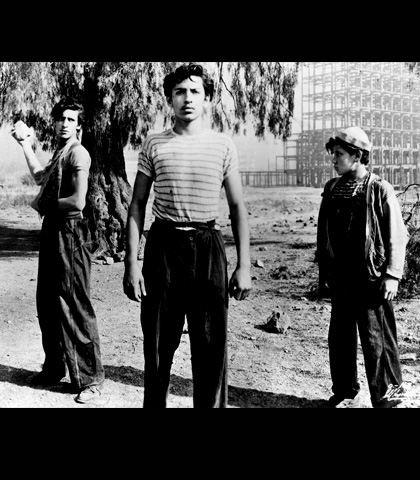

These are the first two pages from Google image search (click on images for better resolution) when you search "lumpenproletariat." Among the top results? A story about how the boyfriend of a spoiled rich bitch from The Hills got in a fight with some "lumpenproletariat." I hope those rag-and-bone-men gave him an informal economy beatdown. Also: Fanon, Jerry Lewis, Frank Sinatra, a cartoon about "lumpy proletariat," Michael Moore, some black jacket, a mixtape. I am quite pleased, however, with the fact that Bubbles from Trailerpark Boys (the bespectacled man with the kitty on the head) is included.

In addition to being brilliantly, painfully funny, Trailerpark Boys is actually a remarkable document of an imagined Canadian lumpenproletariat, represented in the show by the salvage work of refurbishing shopping carts, growing weed (and trying to ship it to the U.S. via a model train through the forest), setting up "rub 'n tiz'zug" parlors (for "massages"), stealing office furniture, and etc. In addition, it grasps the non-accumulation of these activities: each season begins with them in jail and ends with them back in jail. Between these endpoints comes the inevitable promise to not go back to jail this year. Our pleasure, then, is in the lack of apparent consequence. No escalation of sentences. And the fact that Ricky quite enjoys jail ("they feed you, they got great dope, we play street hockey... don't be dissin' jail, Julien").
Perhaps the lesson to be learned here is that we (and Google, in the seemingly absurd collection of pages called up by the search) only can image the lumpenproletariat as exceptions, as a wrong vision of that which is itself heterogeneous, inconstant, defined by its absence of consistency. The great films of lumpen-vision (

Fritz Lang's M, in which we get the totality of that underground organization and their lines of flight,

Eisenstein's Strike!, which gives us barrel dwelling, totemic figures, the heart of Pasolini's body of work, a significant portion of The Wire, Takovskij's The Stalker, much of Herzog,

the Tim Burton Batman films, etc, etc, etc) all appear as liminal cases, of singular figures that are either too exemplary to be generalized, or too faceless, just a blur of grime and rags and crime.
As such, the giving-shape-to of the lumpenproletariat is anamorphotic work, a necessary looking askance to see that categorical misfire: a commonality of exceptions that is the under-truth of how capitalism forms the space between universality and its excluded constitutients. Those who stand outside, who cannot be recuperated, represent a sort of logical threat, as they are the uncanny mirror of capital: black markets, prostitution, kleptocracy, entrepreneurship in the remobilizing of the unwanted waste of the system, accumulation by "dispossession," naked force, swindles.
For behind all riches stand an army of rags, mimicking, impersonating, haunting: singular faces that are the any-face, and the endless, grinding toil of uncategorizable work.




No comments:
Post a Comment